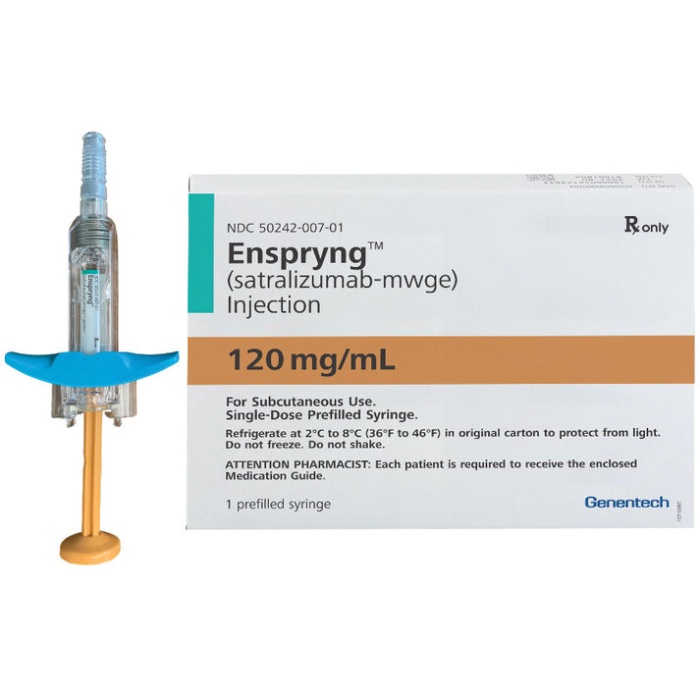
Como usar ENSPRYNG 120 mg SOLUÇÃO INJETÁVEL EM SERINGA PREENCHIDA
Introdução
Prospecto: informação para o paciente
Enspryng 120 mg solução injetável em seringa pré-carregada
satralizumab
Este medicamento está sujeito a acompanhamento adicional, o que agilizará a detecção de nova informação sobre a sua segurança. Pode contribuir comunicando os efeitos adversos que possa ter. A parte final da seção 4 inclui informação sobre como comunicar esses efeitos adversos.
Leia todo o prospecto atentamente antes de começar a usar este medicamento, porque contém informação importante para si.
- Conserva este prospecto, porque pode ter que voltar a lê-lo.
- Se tiver alguma dúvida, consulte o seu médico, farmacêutico ou enfermeiro.
- Este medicamento foi prescrito apenas para si, e não deve dá-lo a outras pessoas, mesmo que tenham os mesmos sintomas que si, porque pode prejudicá-las.
- Se experimentar efeitos adversos, consulte o seu médico, farmacêutico ou enfermeiro, mesmo que se trate de efeitos adversos que não aparecem neste prospecto. Ver seção 4.
Além deste prospecto, o seu médico também lhe entregará uma carta de informação para o paciente, que contém informação de segurança importante que deve conhecer antes e durante o tratamento com Enspryng. Mantenha esta carta de informação consigo em todo o momento.
Conteúdo do prospecto
- O que é Enspryng e para que se utiliza
- O que precisa saber antes de começar a usar Enspryng
- Como usar Enspryng
- Posíveis efeitos adversos
- Conservação de Enspryng
- Conteúdo do envase e informação adicional
Instruções de uso
1. O que é Enspryng e para que se utiliza
O que é Enspryng
Enspryng contém o princípio ativo satralizumab. Trata-se de um tipo de proteína denominada anticorpo monoclonal. Os anticorpos monoclonais estão projetados para reconhecer uma substância específica do organismo e unir-se a ela.
Para que se utiliza Enspryng
Enspryng é um medicamento que se utiliza para o tratamento do transtorno do espectro da neuromielite óptica (TENMO) em adultos e adolescentes a partir dos 12 anos.
O que se entende por TENMO
TENMO refere-se a uma doença do sistema nervoso central que afeta principalmente os nervos ópticos e a medula espinhal. Produz-se por um funcionamento incorrecto do sistema imunológico (as defesas do corpo) que ataca os nervos do corpo.
- O dano aos nervos ópticos provoca uma inflamação que, por sua vez, produz dor e perda de visão.
- O dano à medula espinhal provoca fraqueza ou perda da mobilidade das pernas ou dos braços, perda da sensibilidade e problemas com a função vesical ou intestinal.
Em um surto de TENMO, produz-se uma inflamação no sistema nervoso. Também se produz quando a doença se repete (recidiva). A inflamação produz sintomas novos ou que se repitam sintomas previos.
Como actua Enspryng
Enspryng bloqueia a ação de uma proteína chamada interleucina 6 (IL-6), a qual está envolvida no processo que conduz ao dano e inflamação no sistema nervoso. Ao bloquear seus efeitos, Enspryng reduz o risco de recidiva ou surto do TENMO.
2. O que precisa saber antes de começar a usar Enspryng
Não use Enspryng:
- se é alérgico a satralizumab ou a algum dos outros componentes deste medicamento (incluídos na seção 6).
Se se encontra em alguma das circunstâncias anteriores ou não está seguro, não utilize Enspryng e consulte o seu médico, farmacêutico ou enfermeiro.
Advertências e precauções
Se experimentar alguma reação adversa, contacte o seu médico imediatamente (ver seção 4. Posíveis efeitos adversos).
Consulte o seu médico, farmacêutico ou enfermeiro antes de começar a usar Enspryng se se encontra em alguma das circunstâncias seguintes (ou se não está seguro).
Infecções
Não pode usar Enspryng enquanto tiver uma infecção. Informa ao seu médico ou enfermeiro imediatamente se acredita ter algum sinal de infecçãoantes, durante ou após o tratamento com Enspryng, como por exemplo:
- febre ou calafrios
- tosse persistente
- dor de garganta
- herpes labial ou úlceras genitais (herpes simples)
- culebrilha (herpes zóster)
- vermelhidão, inchaço, sensibilidade ou dor na pele
- náuseas ou vómitos, diarreia ou dor de estômago.
Também encontrará esta informação na carta de informação para o paciente que o seu médico lhe forneceu. É importante que tenha esta carta de informação consigo em todo o momento e que a mostre a qualquer médico, enfermeiro ou cuidador.
O seu médico esperará que a infecção esteja controlada antes de administrar-lhe Enspryng ou permitir que continue com as injeções de Enspryng.
Vacinas
Informa ao seu médico se recebeu recentemente alguma vacinaou poderia receber uma em um futuro próximo.
- O seu médico verificará se precisa de alguma vacina antes de começar o tratamento com Enspryng.
- Não deve receber vacinas vivas ou vivas atenuadas (por exemplo, a vacina BCG contra a tuberculose ou as vacinas contra a febre amarela) enquanto estiver em tratamento com Enspryng.
Enzimas hepáticas
Enspryng pode afetar o seu fígado e aumentar a quantidade de algumas enzimas hepáticas presentes no sangue. O seu médico fará análises de sangue antes de começar o tratamento com Enspryng e durante o mesmo, para verificar o funcionamento correcto do fígado. Informa ao seu médico ou enfermeiro imediatamentese apresentar algum dos seguintes sinais de dano no fígado durante ou após o tratamento com Enspryng:
- coloração amarelada da pele e da parte branca dos olhos (icterícia)
- urina de cor escura
- náuseas e vómitos
- dor abdominal
Nível de glóbulos brancos
O seu médico fará análises de sangue antes de começar o tratamento com Enspryng, e durante o mesmo, para rever o seu nível de glóbulos brancos.
Crianças e adolescentes
Este medicamento não deve ser administrado a crianças menores de 12 anos, porque não foi estudado ainda neste grupo de idade.
Outros medicamentos e Enspryng
Informa ao seu médico ou farmacêutico se está tomando, tomou recentemente ou poderia ter que tomar qualquer outro medicamento.
Informa ao seu médico ou farmacêutico se está tomando medicamentos como warfarina, carbamazepina, fenitoína e teofilina, porque poderia ser necessário ajustar as doses.
Gravidez e amamentação
Se está grávida ou em período de amamentação, acredita que possa estar grávida ou tem intenção de engravidar, consulte o seu médico ou farmacêutico antes de utilizar este medicamento.
É possível que o seu médico lhe recomende que interrompa a amamentação se deve receber tratamento com Enspryng. Desconhece-se se Enspryng passa para o leite materno.
Condução e uso de máquinas
Não é provável que Enspryng afete a sua capacidade para conduzir, andar de bicicleta ou utilizar ferramentas ou máquinas.
3. Como usar Enspryng
Siga exactamente as instruções de administração deste medicamento indicadas pelo seu médico ou farmacêutico. Em caso de dúvida, consulte novamente o seu médico ou farmacêutico.
Quantidade de Enspryng que se deve usar
Cada injeção contém 120 mg de satralizumab. A primeira injeção será administrada sob a supervisão do seu médico ou enfermeiro.
- As três primeiras injeções são administradas uma vez cada 2 semanas. São as denominadas “doses de carga”.
- A partir de então, a injeção será administrada cada 4 semanas. É a denominada “dose de manutenção”. Deve continuar com as injeções uma vez cada 4 semanas durante o tempo que o seu médico indicar.
Como usar Enspryng
- Enspryng é administrado por injeção sob a pele (subcutânea).
- Em cada injeção, deve injetar o conteúdo completo da seringa.
No início, é possível que o seu médico ou enfermeiro lhe dê a injeção de Enspryng. No entanto, o seu médico poderia decidir que si pode dar as injeções de Enspryng ou que pode dá-las um cuidador adulto.
- Si ou o seu cuidador receberão formação para aprender a dar as injeções de Enspryng.
- Fale com o seu médico ou enfermeiro se si ou o seu cuidador tiverem alguma pergunta sobre a administração das injeções.
Leia atentamente e siga as “Instruções de uso” que figuram no final deste prospecto sobre como injetar Enspryng.
Se usar mais Enspryng do que deve
Como Enspryng está dentro de uma seringa pré-carregada, é pouco provável que receba uma quantidade excessiva. No entanto, se está preocupado, consulte o seu médico, farmacêutico ou enfermeiro.
Se, de forma acidental, se injetar mais doses do que deveria, deve contactar o seu médico. Quando for ao médico, leve sempre o embalagem exterior.
Se esquecer de usar Enspryng
Para que o tratamento seja totalmente eficaz, é muito importante não saltar nenhuma injeção.
Se o seu médico ou enfermeiro lhe está administrando as injeções e si falta a uma consulta, deve marcar outra imediatamente.
Se si está a dar as injeções de Enspryng e si salta uma, dê-a o mais breve possível. Não espere até a próxima dose prevista. Depois de se injetar a dose esquecida, deve dar a próxima dose:
- se é dose de carga: 2 semanas depois
- se é dose de manutenção: 4 semanas depois
Em caso de dúvida, consulte o seu médico, farmacêutico ou enfermeiro.
Se interromper o tratamento com Enspryng
Não interrompa o tratamento com Enspryng de forma repentina sem consultar antes o seu médico. Se tiver alguma outra dúvida sobre o uso deste medicamento, pergunte ao seu médico, farmacêutico ou enfermeiro.
4. Posíveis efeitos adversos
Como todos os medicamentos, este medicamento pode produzir efeitos adversos, embora nem todas as pessoas os sofram.
Reação alérgica
Informa ao seu médico imediatamente ou vá ao serviço de urgências do hospital mais próximo se tiver algum sinal de reação alérgica durante ou após a injeção. Por exemplo:
- opressão no peito ou silvos ao respirar
- sensação de dificuldade para respirar
- febre ou calafrios
- tontura intensa ou sensação de desmaio
- inchaço dos lábios, da língua ou da face
- coceira na pele, urticária ou erupção cutânea.
Não se dê a próxima dose até que tenha falado com o seu médico e ele lhe diga que pode fazê-lo.
Reações relacionadas com a injeção(muito frequentes: podem afetar mais de 1 em cada 10 pessoas)
Na maioria dos casos, trata-se de reações leves, embora algumas possam ser graves.
Informa imediatamente ao seu médico ou enfermeiro se tiver algum desses sinais durante ou após a injeção, especialmente nas primeiras 24 horas após a injeção:
- vermelhidão, coceira, dor ou inchaço no local da injeção
- erupção cutânea, vermelhidão ou coceira da pele ou urticária
- sofocos
- dor de cabeça
- irritação, inchaço ou dor de garganta
- sensação de dificuldade para respirar
- pressão arterial baixa (tontura e sensação de desmaio)
- febre ou calafrios
- sensação de cansaço
- náuseas, vómitos ou diarreia
- frequência cardíaca alta, batimentos cardíacos rápidos ou aumento das pulsações (palpitações).
Informa imediatamente ao seu médico ou enfermeiro se tiver alguns dos sintomas anteriores.
Outros efeitos adversos:
Muito frequentes(podem afetar mais de 1 em cada 10 pessoas):
- dor de cabeça
- dor de articulações
- níveis altos de lípidos no sangue (gorduras)
- nível baixo de glóbulos brancos
Frequentes(podem afetar até 1 em cada 10 pessoas):
- sensação de rigidez
- enxaqueca
- ritmo cardíaco lento (bradicardia)
- aumento da pressão arterial
- incapacidade para conciliar o sono
- inchaço na parte inferior das pernas, dos pés ou das mãos
- erupção cutânea ou coceira
- alergias ou rinite alérgica
- inflamação do estômago (gastrite), incluindo dor de estômago e náuseas
- aumento de peso
- análises de sangue que mostrem:
- níveis baixos de fibrinogênio (uma proteína que intervém na coagulação do sangue)
- nível alto de enzimas hepáticas (transaminases, sinal possível de problemas de fígado)
- nível alto de bilirrubina (sinal possível de problemas de fígado)
- nível baixo de plaquetas (que pode provocar facilmente sangramento e hematomas)
Comunicação de efeitos adversos
Se experimentar qualquer tipo de efeito adverso, consulte o seu médico, farmacêutico ou enfermeiro, mesmo que se trate de possíveis efeitos adversos que não aparecem neste prospecto. Também pode comunicá-los directamente através do sistema nacional de notificação incluído no Apêndice V. Mediante a comunicação de efeitos adversos, pode contribuir para fornecer mais informação sobre a segurança deste medicamento.
5. Conservação de Enspryng
- Mantenha este medicamento fora da vista e do alcance das crianças.
- Não utilize este medicamento após a data de validade que aparece na etiqueta da seringa pré-carregada e na caixa após “CAD”. A data de validade é o último dia do mês que se indica.
- Conserva em frigorífico (entre 2 ºC e 8 ºC). Não congele. Não utilize a seringa se foi congelada. Mantenha sempre a seringa seca.
- Conserva as seringas pré-carregadas no embalagem exterior para protegê-las da luz e da humidade.
- Se for conservado no embalagem exterior e sem abrir, Enspryng pode permanecer fora do frigorífico por debaixo de 30ºC durante um período único de 8 dias como máximo. Não volte a guardar Enspryng no frigorífico.
- Não deve utilizar e deve deitar fora a seringa pré-carregada se esteve fora do frigorífico durante mais de 8 dias.
Não utilize este medicamento se observar que está turvo, mudou de cor ou contém partículas. Enspryng é um líquido incolor a ligeiramente amarelo.
O medicamento deve ser injetado imediatamente após remover a tampa da agulha, e antes de 5 minutos para evitar que o medicamento seque e bloqueie a agulha. Se a seringa pré-carregada não for utilizada num prazo de 5 minutos após remover a tampa, é necessário deitá-la fora num recipiente resistente à perfuração e utilizar uma nova.
Os medicamentos não devem ser deitados fora pelos esgotos nem para o lixo. Pergunte ao seu farmacêutico como se livrar dos embalagens e dos medicamentos que já não precisa. Dessa forma, ajudará a proteger o meio ambiente.
6. Conteúdo do frasco e informações adicionais
Composição de Enspryng
- O princípio ativo é satralizumab. Cada seringa pré-carregada contém 120 mg de satralizumab em 1 ml.
- Os outros componentes são histidina, ácido aspártico, arginina, poloxâmero 188 e água para preparações injetáveis.
Aspecto do produto e conteúdo do frasco
- Trata-se de um líquido incolor a ligeiramente amarelo.
- Enspryng é uma solução injetável.
- Cada frasco de Enspryng contém 1 seringa pré-carregada. Cada frasco múltiplo de Enspryng contém 3 seringas pré-carregadas (3 frascos de 1). Pode ser que apenas alguns tamanhos de frascos estejam comercializados.
Título da autorização de comercialização
Roche Registration GmbH
Emil-Barell-Strasse 1
79639 Grenzach-Wyhlen
Alemanha
Responsável pela fabricação
Roche Pharma AG
Emil-Barell-Strasse 1
79639 Grenzach-Wyhlen
Alemanha
Pode solicitar mais informações sobre este medicamento dirigindo-se ao representante local do titular da autorização de comercialização:
Bélgica N.V. Roche S.A. Tel: +32 (0) 2 525 82 11 | Lituânia UAB “Roche Lietuva” Tel: +370 5 2546799 |
| Luxemburgo (Ver Bélgica) |
República Tcheca Roche s. r. o. Tel: +420 - 2 20382111 | Hungria Roche (Hungria) Kft. Tel: +36 - 1 279 4500 |
Dinamarca Roche Pharmaceuticals A/S Tel: +45 - 36 39 99 99 | Malta (Ver Irlanda) |
Alemanha Roche Pharma AG Tel: +49 (0) 7624 140 | Países Baixos Roche Nederland B.V. Tel: +31 (0) 348 438050 |
Estônia Roche Eesti OÜ Tel: + 372 - 6 177 380 | Noruega Roche Norge AS Tel: +47 - 22 78 90 00 |
Grécia Roche (Hellas) A.E. Tel: +30 210 61 66 100 | Áustria Roche Áustria GmbH Tel: +43 (0) 1 27739 |
Espanha Roche Farma S.A. Tel: +34 - 91 324 81 00 | Polônia Roche Polska Sp.z o.o. Tel: +48 - 22 345 18 88 |
França Roche Tel: +33 (0) 1 47 61 40 00 | Portugal Roche Farmacêutica Química, Lda Tel: +351 - 21 425 70 00 |
Croácia Roche d.o.o. Tel: +385 1 4722 333 | Romênia Roche România S.R.L. Tel: +40 21 206 47 01 |
Irlanda Roche Products (Irlanda) Ltd. Tel: +353 (0) 1 469 0700 | Eslovênia Roche farmacêutica družba d.o.o. Tel: +386 - 1 360 26 00 |
Islândia Roche Pharmaceuticals A/S c/o Icepharma hf Tel: +354 540 8000 | República Eslovaca Roche Slovensko, s.r.o. Tel: +421 - 2 52638201 |
Itália Roche S.p.A. Tel: +39 - 039 2471 | Finlândia Roche Oy Tel: +358 (0) 10 554 500 |
Chipre Γ.Α.Σταμάτης & Σια Λτδ. Tel: +357 - 22 76 62 76 | Suécia Roche AB Tel: +46 (0) 8 726 1200 |
Letônia Roche Latvija SIA Tel: +371 - 6 7039831 | Reino Unido (Irlanda do Norte) Roche Products (Irlanda) Ltd. Tel: +44 (0) 1707 366000 |
Data da última revisão deste folheto:
A informação detalhada sobre este medicamento está disponível no site da Agência Europeia de Medicamentos: http://www.ema.europa.eu.
Também existem links para outros sites sobre doenças raras e medicamentos órfãos.
Instruções de uso
Leia estas instruções de uso:
- Antes de começar a usar a seringa pré-carregada
- Cada vez que lhe for dispensado novamente o medicamento prescrito, caso contenha informações novas.
- Esta informação não substitui a consulta com seu médico ou enfermeiro sobre sua doença ou tratamento.
- Seu médico ou enfermeiro decidirá se você pode se administrar as injeções de Enspryng em casa ou se pode fazê-lo um cuidador. Também lhe mostrará a você ou ao seu cuidador a forma correta e segura de usar a seringa antes de usá-la pela primeira vez.
- Em caso de dúvida, consulte seu médico ou enfermeiro.
Informação importante
- Cada seringa está pré-carregada com um medicamento chamado Enspryng.
- Cada frasco de Enspryng contém apenas 1 seringa pré-carregada.
- Cada seringa pré-carregada pode ser usada apenas uma vez.
- Não compartilhe suas seringas com outras pessoas.
- Não retire o capuchão da agulha até que esteja preparado para se aplicar a injeção de Enspryng.
- Não use a seringa se ela tiver caído ou estiver danificada.
- Não tente desmontar a seringa em nenhum momento.
- Não deixe a seringa sem vigilância.
- Não reutilize a mesma seringa.
Materiais necessários para aplicar a injeção
Cada frasco de Enspryng contém:
- 1 seringa pré-carregada de uso único.
Também precisará do seguinte, pois não está incluído no frasco:

- 1 toalha impregnada em álcool
- 1 bola de algodão ou gaze estéril
- 1 tirinha
- 1 recipiente resistente à perfuração para agulhas para descartar de forma segura o capuchão da agulha e a seringa usada. Ver o passo 21 “Como descartar Enspryng” no final destas instruções de uso.
Seringa pré-carregada Enspryng
(ver figuras A e B)
Antes do uso:
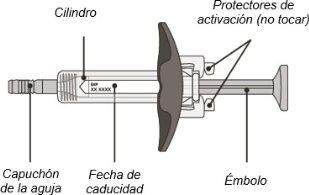
Figura A
Depois do uso:
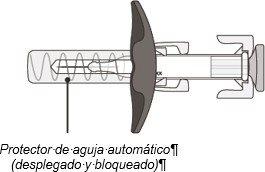
Figura B
A seringa tem um protetor de agulha automático que cobre a agulha quando a injeção é finalizada.
Prepare-se para a administração de Enspryng
- Tire o frasco da geladeira e coloque-o sobre uma superfície de trabalho limpa e plana (como uma mesa).
- Verifique a data de validade na parte traseira do frasco (ver figura C). Nãouse a seringa se o frasco tiver expirado.
- Verifique se a parte frontal do frasco está bem selada (ver figura C). Nãouse a seringa se o selo de segurança do frasco estiver quebrado.
Se a data de validade tiver expirado ou o selo estiver quebrado, vá para o passo 21 “Como descartar Enspryng” e entre em contato com seu médico ou enfermeiro.
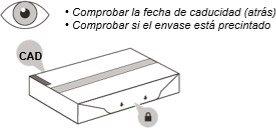
Figura C
- Abrir o frasco selado (ver figura D).

Figura D
- Tire com cuidado a seringa do frasco segurando-a pelo cilindro (ver figura E).
- Não coloque o frasco de cabeça para baixo para tirar a seringa.
- Não toque nos protetores de ativação, pois pode danificar a seringa.
- Não segure a seringa pelo êmbolo ou pelo capuchão da agulha.
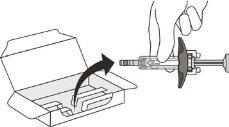
Figura E
Examine a seringa
(ver figura F)
- Verifique a data de validade da seringa. Nãouse a seringa se ela tiver expirado.
- Inspeccione a seringa para verificar se não há danos. Nãoa use se ela estiver rachada ou quebrada.
- Através do visor, verifique se o líquido é transparente e incolor a ligeiramente amarelo.
Nãose injete o medicamento se o líquido estiver turvo, tiver mudado de cor ou contiver partículas.
- Pode haver pequenas bolhas de ar na seringa. Isso é normal e não deve tentar eliminá-las.
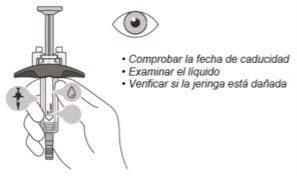
Figura F
Se a data de validade tiver expirado, a seringa estiver danificada ou o líquido estiver turvo, tiver mudado de cor ou contiver partículas, não use o medicamento. Em seguida, vá para o passo 21 “Como descartar Enspryng” e entre em contato com seu médico ou enfermeiro.
Deixe a seringa atingir a temperatura ambiente
- Uma vez que tenha examinado a seringa, deixe-a sobre uma superfície de trabalho limpa e plana (como uma mesa) durante 30 minutospara que atinja a temperatura ambiente (ver figura G).
É importante deixar que a seringa atinja suavemente a temperatura ambiente, pois o medicamento frio pode ser incômodo e é mais difícil empurrar o êmbolo.
- Não acelere o processo de aquecimento aquecendo a seringa de nenhuma forma.
- Não retire o capuchão da agulha enquanto espera que a seringa atinja a temperatura ambiente.

Figura G
Lave as mãos
- Lave as mãos com água e sabão (ver figura H).
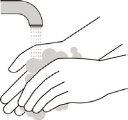
Figura H
Escolha o local da injeção
- Escolha um local de injeção entre os seguintes:
- a parte inferior da barriga (abdomen) ou
- a parte frontal e média dos músculos da coxa (ver figura I).
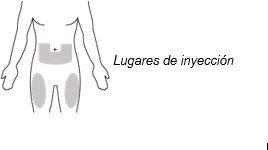
Figura I
- Não se aplique a injeção nos 5 cm ao redor do umbigo.
- Não se aplique a injeção em moluscos, cicatrizes, hematomas ou áreas onde a pele esteja sensível, vermelha, dura ou danificada.
Escolha um local de injeção diferente para cada injeção nova. Escolha um local diferente para cada nova injeção, que esteja como mínimo a 2,5 cm de distância do local escolhido da última vez.
Limpe o local da injeção
- Limpe o local da injeção com uma toalha impregnada em álcool e deixe que seque ao ar.
- Não se abanique nem sopre sobre a área limpa.
- Não toque novamente no local da injeção antes de se aplicar a injeção.
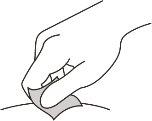
Figura J
Como injetar Enspryng
- Segure o cilindro da seringa com o polegar e o dedo indicador. Com a outra mão, puxe o capuchão da agulha para removê-lo. É possível que veja uma gota de líquido no final da agulha, é normal e não afetará a dose (ver figura K).
- Use a seringa nos 5 minutos seguintes à remoção do capuchão; caso contrário, a agulha pode se obstruir.
- Não retire o capuchão da agulha até que esteja preparado para se aplicar a injeção de Enspryng.
- Não recoloque o capuchão na agulha uma vez que o tenha removido, pois pode danificar a agulha.
- Não toque na agulha nem deixe que ela toque em nenhuma superfície após remover o capuchão.
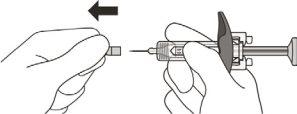
Figura K
- Descarte imediatamente o capuchão da agulha no recipiente resistente à perfuração para o descarte de agulhas. Ver o passo 21 “Como descartar Enspryng”.
- Segure o cilindro da seringa com o polegar e o dedo indicador. Com a outra mão, puxe a área da pele que limpou (ver figura L).
- Com um movimento rápido, como ao lançar um dardo, insira a agulha na pele com um ângulo de 45º a 90º (ver figura L).
- Não altere o ângulo da injeção enquanto a realiza.
- Não insira a agulha novamente.
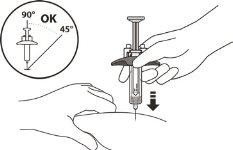
Figura L
- Uma vez que a agulha esteja inserida, solte suavemente a pele que estava puxada.
- Injete lentamente todo o medicamento empurrando suavemente o êmbolo para baixo até que ele atinja os protetores de ativação (ver figura M).
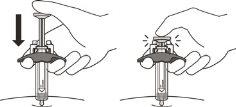
Figura M
- Solte com cuidado o êmbolo e deixe que a agulha saia da pele mantendo o mesmo ângulo com o qual a inseriu (ver figura N).
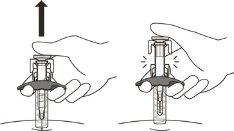
Figura N
- Em seguida, o protetor automático da agulhacobrirá a agulha. Se a agulha não for coberta, coloque com cuidado a seringa em um recipiente resistente à perfuração para o descarte de agulhas para evitar lesões. Ver o passo 21 “Como descartar Enspryng”.
Cuidado com o local da injeção
- É possível que ocorra um pouco de sangramento no local da injeção. Pode pressionar o local da injeção com uma bola de algodão ou gaze estéril até que pare de sangrar, mas sem friccionar. Se necessário, também pode cobrir o local da injeção com uma tirinha. Se o medicamento entrar em contato com a pele, lave a área com água.
Como descartar Enspryng
- Não tente recolocar o capuchão na seringa. Coloque a seringa usada em um recipiente para o descarte de agulhas imediatamente após seu uso (ver figura O). Não jogue a seringa no lixo de sua casa nem a recicle.
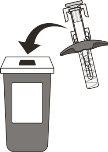
Figura O
- Pergunte a seu médico, enfermeiro ou farmacêutico onde pode obter um recipiente “para agulhas” ou que outro tipo de recipiente resistente à perfuração pode usar para descartar de forma segura as seringas usadas e os capuchões da agulha.
- Descarte todo o recipiente para o descarte de agulhas conforme indicado por seu médico ou farmacêutico.
- Não jogue o recipiente para o descarte de agulhas no lixo de sua casa.
- Não recicle o recipiente para o descarte de agulhas usado.
- País de registo
- Substância ativa
- Requer receita médicaSim
- Fabricante
- Esta informação é apenas para referência e não constitui aconselhamento médico. Consulte sempre um médico antes de tomar qualquer medicamento. A Oladoctor não se responsabiliza por decisões médicas baseadas neste conteúdo.
- Alternativas a ENSPRYNG 120 mg SOLUÇÃO INJETÁVEL EM SERINGA PREENCHIDAForma farmacêutica: PERFURAÇÃO INJETÁVEL, 130 mgSubstância ativa: ustekinumabFabricante: Accord Healthcare S.L.U.Requer receita médicaForma farmacêutica: INJETÁVEL, 45 mgSubstância ativa: ustekinumabFabricante: Accord Healthcare S.L.U.Requer receita médicaForma farmacêutica: INJETÁVEL, 90 mgSubstância ativa: ustekinumabFabricante: Accord Healthcare S.L.U.Requer receita médica
Médicos online para ENSPRYNG 120 mg SOLUÇÃO INJETÁVEL EM SERINGA PREENCHIDA
Avaliação de posologia, efeitos secundários, interações, contraindicações e renovação da receita de ENSPRYNG 120 mg SOLUÇÃO INJETÁVEL EM SERINGA PREENCHIDA – sujeita a avaliação médica e regras locais.



